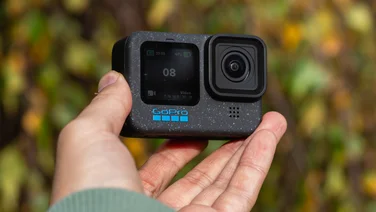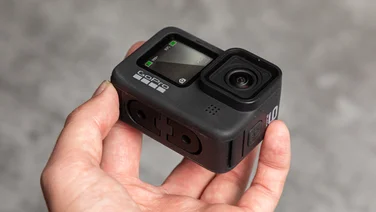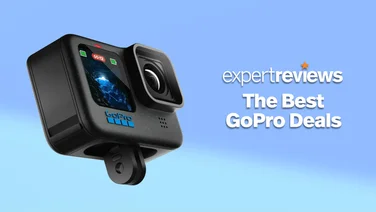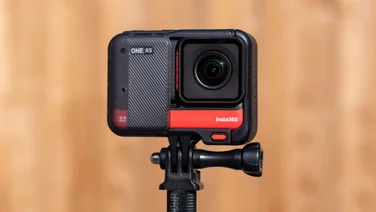To help us provide you with free impartial advice, we may earn a commission if you buy through links on our site. Learn more

















- Lightweight and foldable
- Decent camera quality
- Quiet and easy to fly
- FPV goggles are a pricey extra – and basic
- No object avoidance tech
Parrot has been making drones for as long as there’s been a market for them and the Anafi is the best it has produced so far. With a 4K camera strapped to the front that can film vertically up and down, and a lightweight, foldable body, it was the first consumer camera drone to pose a serious challenge to industry heavyweight, DJI, and it’s now been improved with the addition of FPV (first person view) goggles.
FPV is a technology that’s been around for a while, mostly in drone racing circles. Taking the form of a VR-style headset, FPV goggles are designed to provide the sensation of flying the drone as if the pilot was in the cockpit by streaming the drone’s camera feed directly to a screen in front of your eyes.
READ NEXT: The best camera drones to buy today
Parrot Anafi FPV review: What you need to know
Normally, FPV goggles have their own, built-in display, but the Anafi’s FPV goggles work more like Samsung’s Gear VR or Google’s Daydream View headsets in that you need to clamp your phone onto the front of the goggles to provide the display. The headset itself is merely a pair of adjustable lenses fitted in a plastic, collapsible frame with adjustable elastic straps to keep it attached to your head.
Other than the addition of the FPV goggles, however, and the accompanying new FPV mode within the Parrot Freeflight Pro app, this drone is precisely the same from a hardware perspective as the original Parrot Anafi.
In summary, it’s a fun drone to fly with a pretty decent 4K camera and plenty of camera modes to play around with. It isn’t quite a match for the DJI Mavic Air but, for newbie pilots, its light weight and relatively quiet operation give it some advantages over DJI’s compact flyer.
Parrot Anafi FPV review: Price and competition
With the simplicity of the Parrot Anafi’s FPV system in mind, it’s somewhat surprising that Parrot has tagged on an extra £100 cost for the FPV model. Essentially, you’re paying for a fancy Google cardboard here; although there are a couple of buttons for bringing up the menus and quick switching between the drone and phone cameras, all these do is push a couple of small capacitive pads onto your phone’s display.

















That brings the total up to £730 for the Parrot Anafi versus £628 for the regular version and, aside from the goggles and a slimline backpack to stow everything in, you don’t get anything more than you do with the standard package. Just like the regular Anafi, you get the drone with a spare set of rotor blades, a remote control with a spring-loaded bracket in which to mount your phone, the FPV goggles, a 16GB microSD card and a USB cable.
To put this in context, you can pick up the DJI Mavic Air, admittedly without the FPV goggles, for less on Amazon. The Parrot is the better value drone overall but the Mavic is more fully featured and has a better quality camera.
Parrot Anafi FPV review: FPV mode and goggles
If you want to know about the core camera features and how the Anafi flies, allow me to respectfully direct you to my original review. There’s no difference between the two models at all, which means that all the strengths (quietness and ease of use) and weaknesses (no automatic object avoidance) remain from the original.
As for the FPV mode, I was surprised at how good it was, given how basic the headset is. I’ve only had the opportunity to test it out on a couple of flights but even at sunrise, with the camera pointed directly towards the sun, I was still able to see clearly exactly where I was flying, and, after only a few minutes of flying with the goggles on, I was soon pretty comfortable.

















The feed from the drone’s camera is only 720p and the frame rate is far from smooth but this is all you need for casual FPV flying and framing shots for video and stills. If anything, flying in this way feels more natural, so much so that I ended up flying much further away than I am normally comfortable with on a first outing with a drone.
Setup is pretty straightforward, too, although getting everything assembled and ready before you fly can be a bit of a faff. That’s because you have to select the FPV option in the Parrot app before you put the phone into the goggles, then connect your phone with the controller via USB before donning the headset and taking off.

















I found that the goggles worked across a variety of phones, with a decent range of screen sizes. It was as happy displaying a crisp, perfectly focused image from the 7.2in screen of a Huawei Mate 20 X as it was with my iPhone Xs Max, despite the fact that Parrot says it recommends you only use phones with screens up to 6.5in in size.
It’s even possible to access all the drone’s flight mode and camera settings with the FPV goggles strapped to your face, although you should take care when doing so. Once you push the settings mode button, the controller sticks are used to navigate the menus locking you out of the flight controls – and those menus also obscure the view from the drone’s camera. You should always have a spotter with you, anyway, to keep an eye on where the Anafi is in the sky while you’re flying in FPV mode but this is a bit of a concern.

















Parrot Anafi FPV review: Other new features
Alongside the FPV mode and goggles there are some other new features. The biggie is a new flight mode called Arcade, which is designed to make the drone easier to fly for new pilots. In this mode, the left stick controls the camera, while the right stick controls forwards, backwards and sideways movement; point the camera up and push forward on the right stick and the drone will fly in that direction.
This is quite different from the normal way of operating the Anafi, which sees the left stick controlling altitude and rotation, the right stick moving the drone forwards, backwards and sideways and the shoulder toggle controlling camera tilt. While Arcade mode is a nice to have feature, I felt it doesn’t quite give you the level of control the regular controls do.

















Last, but by no means least, Parrot has added a pair of new flight presets: Cinematic and Racing. While the regular camera presets keep the camera level and locked to the horizon and stable, these two will follow the banking motion of any turns you make, lending more drama to your airborne shots. The difference between them is that Cinematic delivers smooth, stable footage while Racing shots are more abrupt in their motion.
Parrot Anafi FPV review: Verdict
Back when I first reviewed the Parrot Anafi, I liked it so much I gave it five stars. The Anafi FPV is a little tougher to be quite so positive about. That’s because, essentially, it’s the same drone but with a pair of passive VR goggles included in the box with a thumping £100 extra charge for it.
Given that you could achieve a similar effect with a Google Cardboard headset and a bit of elastic strapping (albeit without the ability to switch easily in and out of settings mode) that seems an awful lot to ask.
Still, the inclusion of the backpack does soften the blow somewhat and, if you do want FPV badly enough, it’s probably a good idea to stick with the manufacturer-crafted solution, even if the additional cost price does grate a little.
Overall, the Parrot Anafi remains great value drone and a good alternative for those who crave a little more simplicity or who don’t want to splash out on a DJI Mavic Air. Just make sure you really want the FPV capability before you spend the extra cash.






